Abstract
The kinetics of degradation of bacterial deoxyribonucleic acid (DNA) after infection of Escherichia coli with T4D, ultraviolet-irradiated T4D, and two amber mutants, N122 and N94, was studied by zone sedimentation through linear glycerol gradients. Within 5 min after infection with any of the bacteriophages, breakdown of host genome was evident. The first product was a high-molecular-weight material (50S to 70S) and further degradation appeared to occur in discrete steps. Rapid and extensive breakdown of bacterial DNA was seen after infection with am N122 and T4D. Infection with ultraviolet-irradiated phage or with am N94 resulted in an accumulation of high-molecular-weight material. These results suggest that the observed degradation of host DNA begins early and requires sequential action of several phage-induced endo- as well as exodeoxyribonucleases.
Full text
PDF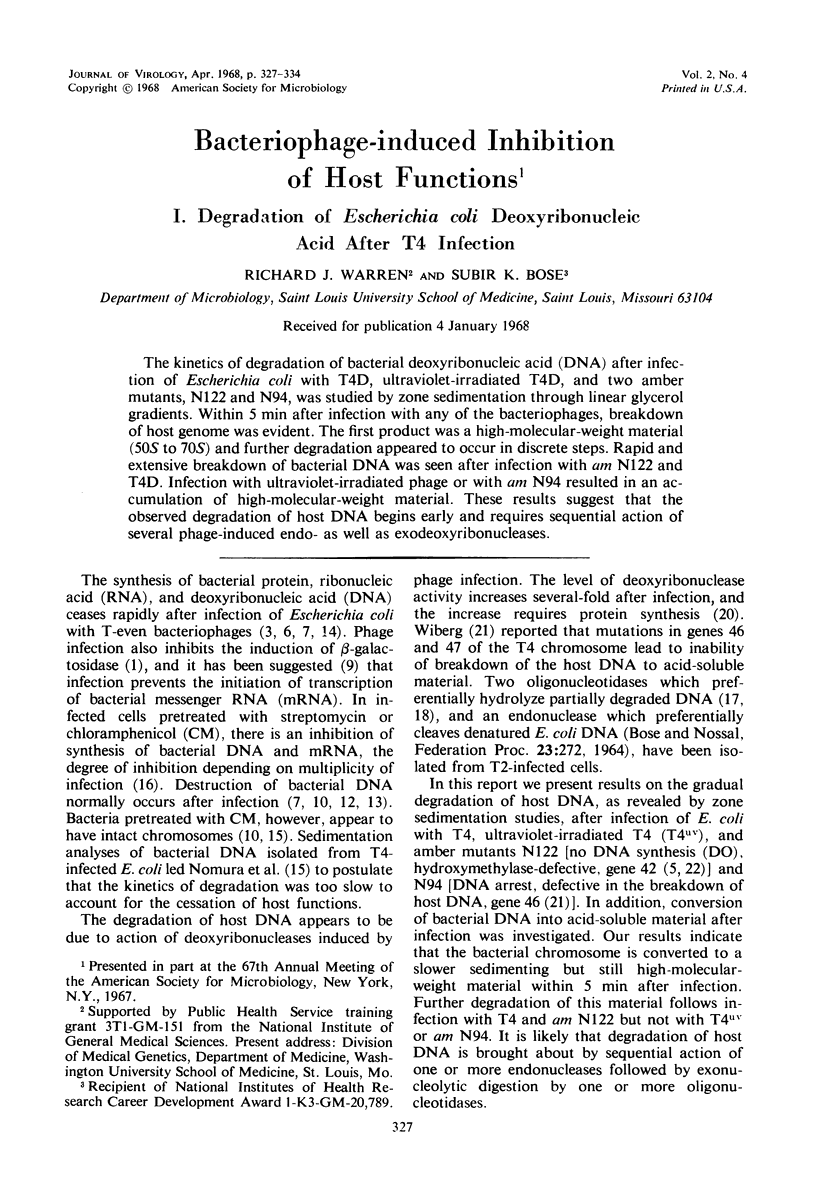

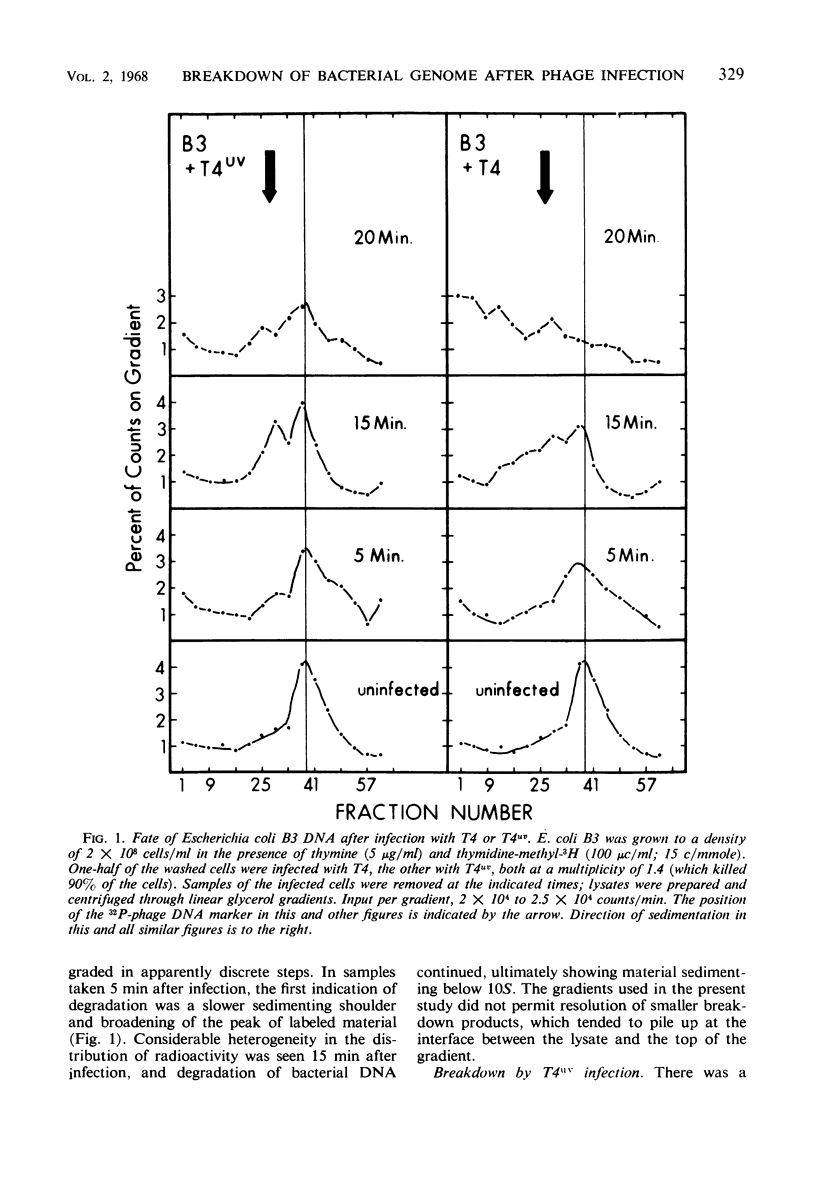
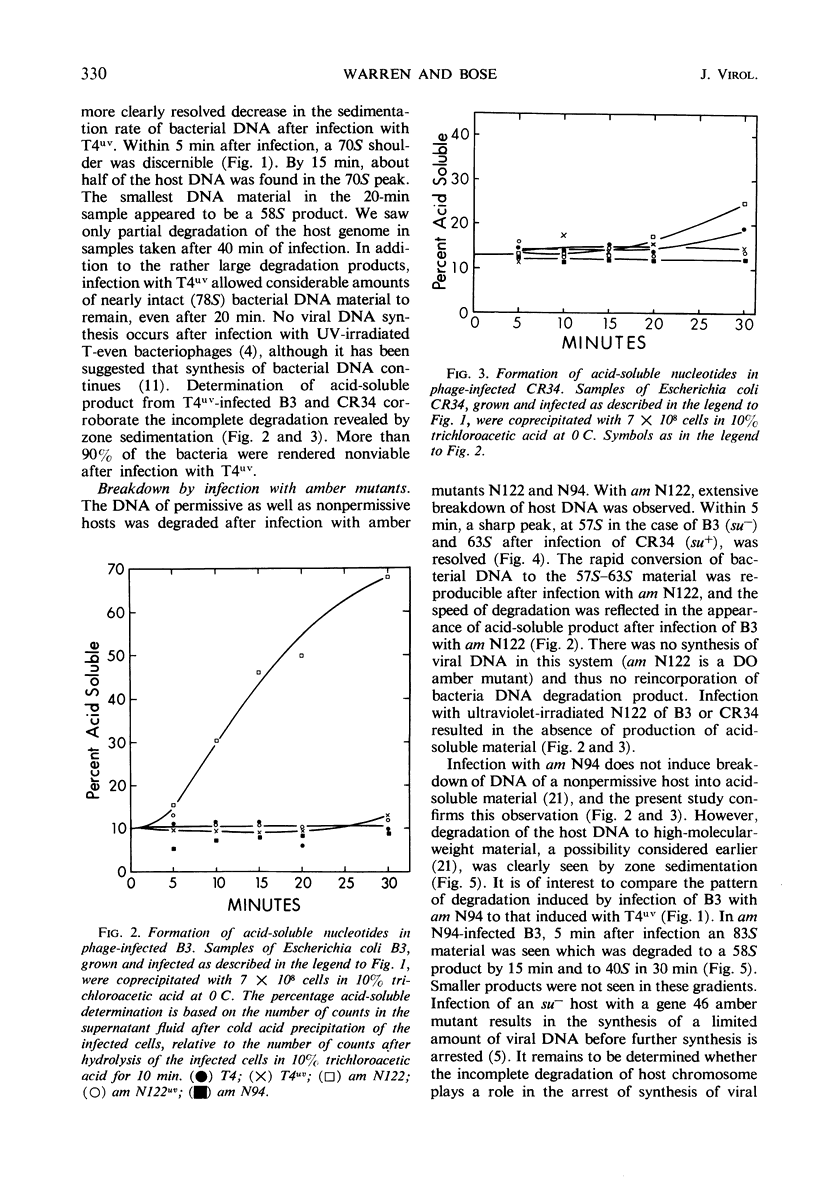
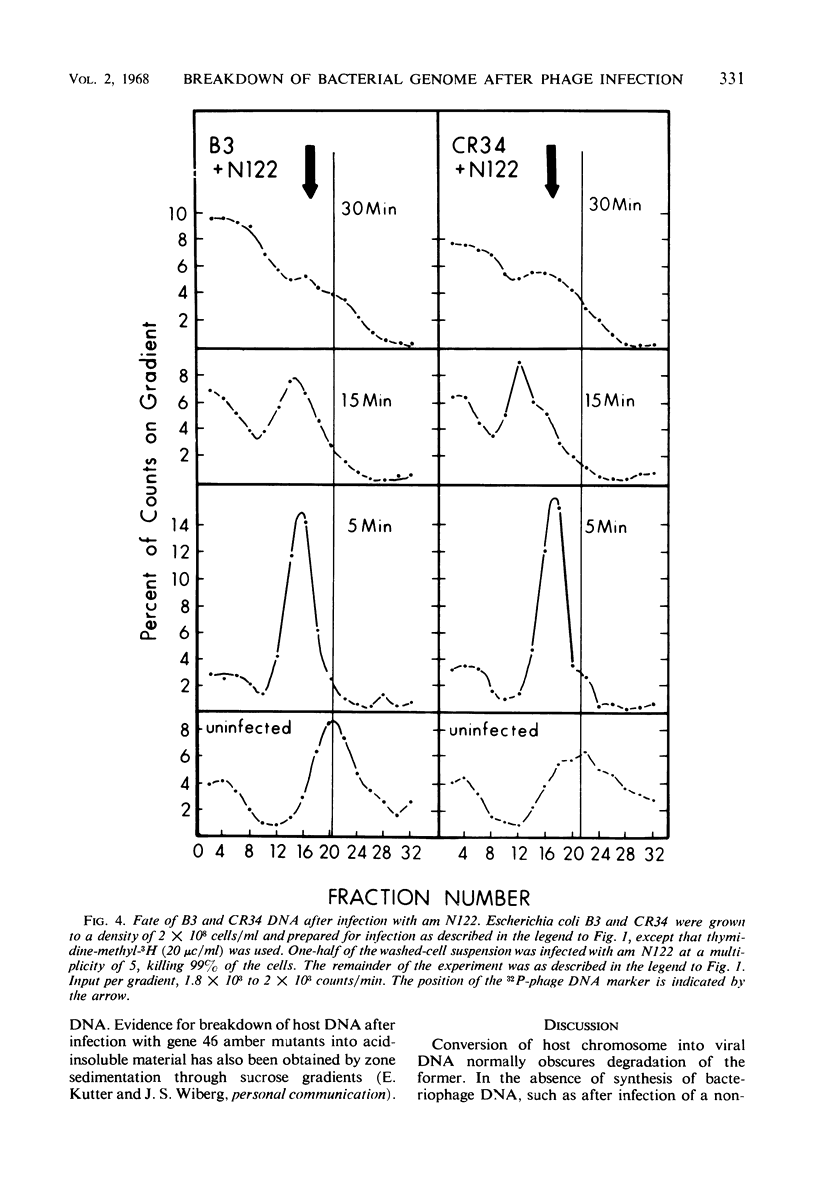
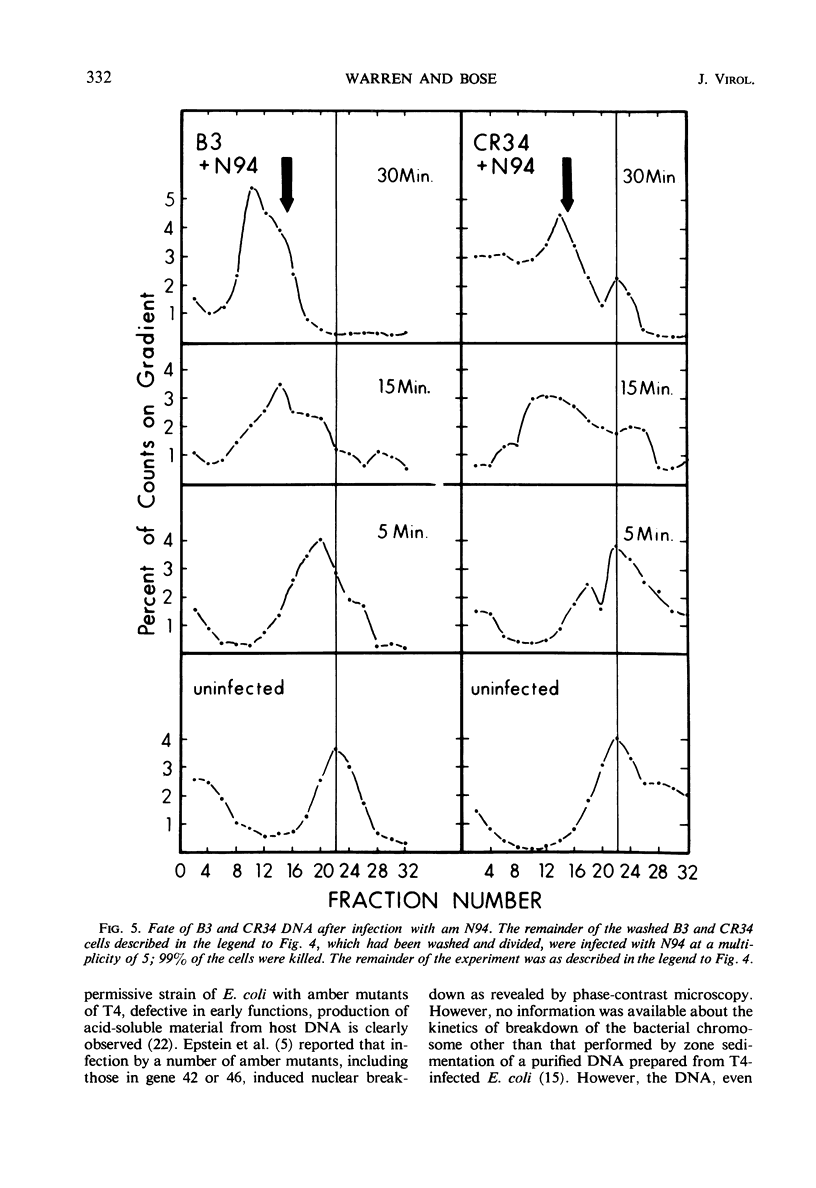
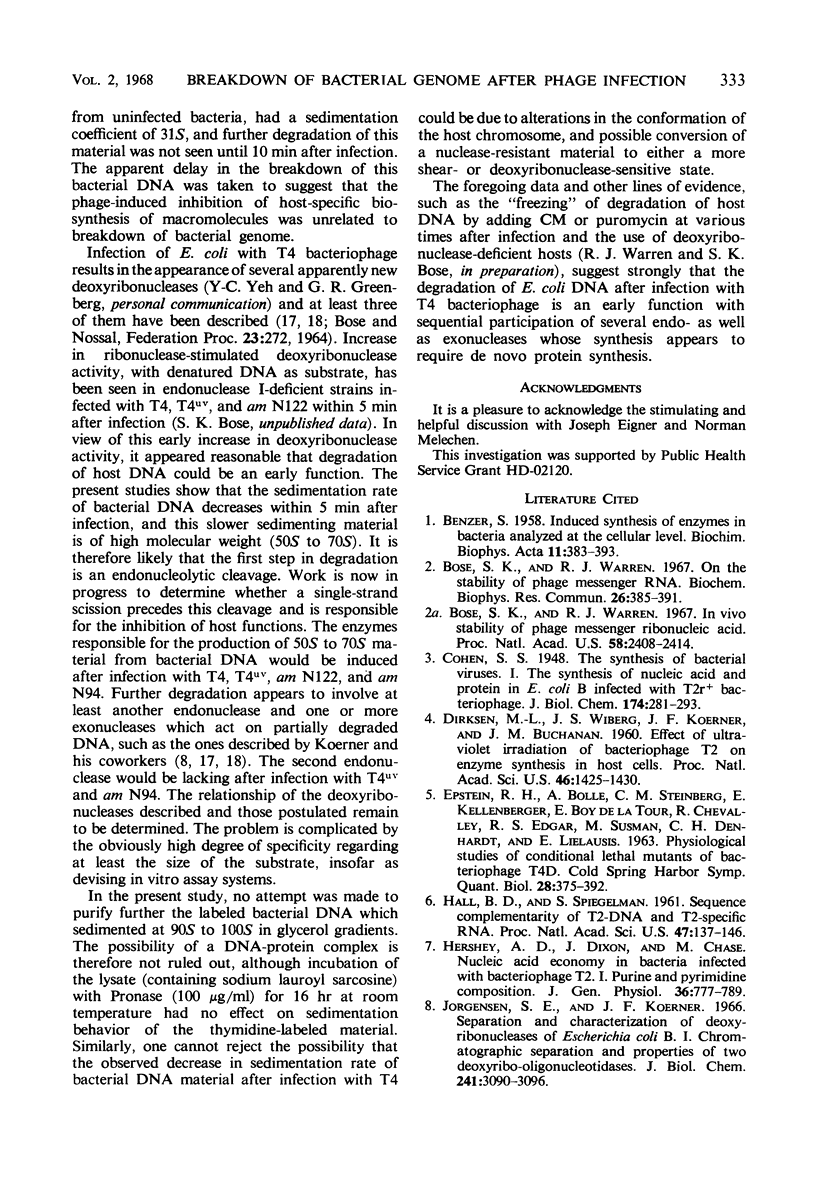
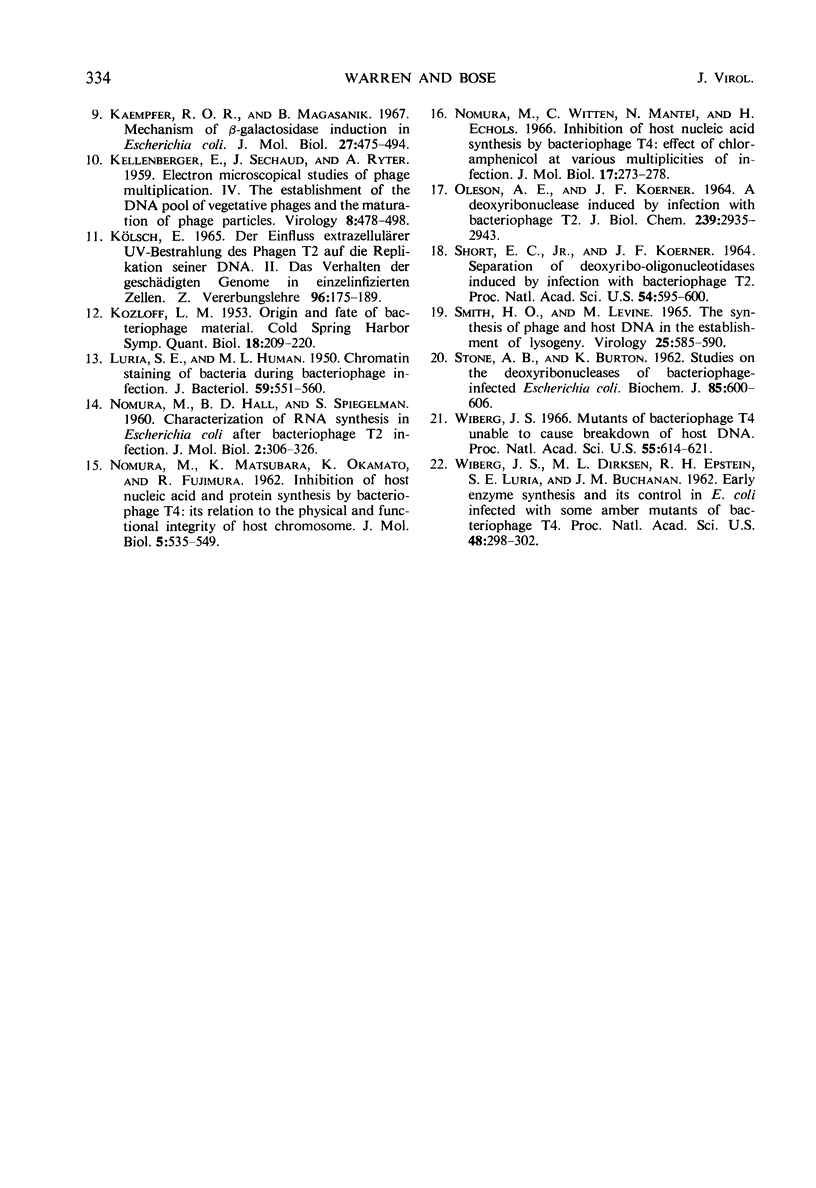
Selected References
These references are in PubMed. This may not be the complete list of references from this article.
- BENZER S. Induced synthesis of enzymes in bacteria analyzed at the cellular level. Biochim Biophys Acta. 1953 Jul;11(3):383–395. doi: 10.1016/0006-3002(53)90057-2. [DOI] [PubMed] [Google Scholar]
- Bose S. K., Warren R. J. In vitro stability of phage messenger ribonucleic acid. Proc Natl Acad Sci U S A. 1967 Dec;58(6):2408–2414. doi: 10.1073/pnas.58.6.2408. [DOI] [PMC free article] [PubMed] [Google Scholar]
- Bose S. K., Warren R. J. On the stability of phage messenger RNA. Biochem Biophys Res Commun. 1967 Feb 21;26(4):385–391. doi: 10.1016/0006-291x(67)90557-8. [DOI] [PubMed] [Google Scholar]
- Dirksen M. L., Wiberg J. S., Koerner J. F., Buchanan J. M. EFFECT OF ULTRAVIOLET IRRADIATION OF BACTERIOPHAGE T2 ON ENZYME SYNTHESIS IN HOST CELLS. Proc Natl Acad Sci U S A. 1960 Nov;46(11):1425–1430. doi: 10.1073/pnas.46.11.1425. [DOI] [PMC free article] [PubMed] [Google Scholar]
- HALL B. D., SPIEGELMAN S. Sequence complementarity of T2-DNA and T2-specific RNA. Proc Natl Acad Sci U S A. 1961 Feb 15;47:137–163. doi: 10.1073/pnas.47.2.137. [DOI] [PMC free article] [PubMed] [Google Scholar]
- Jorgensen S. E., Koerner J. F. Separation and characterization of deoxyribonucleases of Escherichia coli B. I. Chromatographic separation and properties of two deoxyribo-oligonucleotidases. J Biol Chem. 1966 Jul 10;241(13):3090–3096. [PubMed] [Google Scholar]
- KELLENBERGER E., SECHAUD J., RYTER A. Electron microscopical studies of phage multiplication. IV. The establishment of the DNA pool of vegetative phage and the maturation of phage particles. Virology. 1959 Aug;8:478–498. doi: 10.1016/0042-6822(59)90050-9. [DOI] [PubMed] [Google Scholar]
- KOZLOFF L. M. Origin and fate of bacteriophage material. Cold Spring Harb Symp Quant Biol. 1953;18:209–220. doi: 10.1101/sqb.1953.018.01.032. [DOI] [PubMed] [Google Scholar]
- Kaempfer R. O., Magasanik B. Mechanism of beta-galactosidase induction in Escherichia coli. J Mol Biol. 1967 Aug 14;27(3):475–494. doi: 10.1016/0022-2836(67)90053-8. [DOI] [PubMed] [Google Scholar]
- LURIA S. E., HUMAN M. L. Chromatin staining of bacteria during bacteriophage infection. J Bacteriol. 1950 Apr;59(4):551–560. doi: 10.1128/jb.59.4.551-560.1950. [DOI] [PMC free article] [PubMed] [Google Scholar]
- Nomura M., Witten C., Mantei N., Echols H. Inhibition of host nucleic acid synthesis by bacteriophage T4: effect of chloramphenicol at various multiplicities of infection. J Mol Biol. 1966 May;17(1):273–278. doi: 10.1016/s0022-2836(66)80107-9. [DOI] [PubMed] [Google Scholar]
- OLESON A. E., KOERNER J. F. A DEOXYRIBONUCLEASE INDUCED BY INFECTION WITH BACTERIOPHAGE T2. J Biol Chem. 1964 Sep;239:2935–2943. [PubMed] [Google Scholar]
- SMITH H. O., LEVINE M. THE SYNTHESIS OF PHAGE AND HOST DNA IN THE ESTABLISHMENT OF LYSOGENY. Virology. 1965 Apr;25:585–590. doi: 10.1016/0042-6822(65)90086-3. [DOI] [PubMed] [Google Scholar]
- STONE A. B., BURTON K. Studies on the deoxyribonucleases of bacteriophage-infected Escherichia coli. Biochem J. 1962 Dec;85:600–606. doi: 10.1042/bj0850600. [DOI] [PMC free article] [PubMed] [Google Scholar]
- Short E. C., Jr, Koerner J. F. Separation of deoxyribo-oligonucleotidases induced by infection with bacteriophage T2. Proc Natl Acad Sci U S A. 1965 Aug;54(2):595–600. doi: 10.1073/pnas.54.2.595. [DOI] [PMC free article] [PubMed] [Google Scholar]
- WIBERG J. S., DIRKSEN M. L., EPSTEIN R. H., LURIA S. E., BUCHANAN J. M. Early enzyme synthesis and its control in E. coli infected with some amber mutants of bacteriophage T4. Proc Natl Acad Sci U S A. 1962 Feb;48:293–302. doi: 10.1073/pnas.48.2.293. [DOI] [PMC free article] [PubMed] [Google Scholar]
- Wiberg J. S. Mutants of bacteriophage T4 unable to cause breakdown of host DNA. Proc Natl Acad Sci U S A. 1966 Mar;55(3):614–621. doi: 10.1073/pnas.55.3.614. [DOI] [PMC free article] [PubMed] [Google Scholar]


